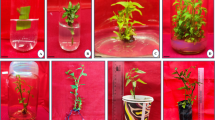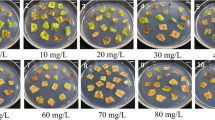Abstract
A mannose selection system was adapted for Agrobacterium-mediated transformation of plum (Prunus domestica L.) hypocotyl explants and the recovery of transgenic plants. Adventitious regeneration from non-transformed hypocotyl sections was inhibited when 3 mg/l mannose, combined with 10 mg/l sucrose, was added to the medium. Mature seed hypocotyl slices from the cultivar ‘Claudia Verde’ were infected with A. tumefaciens AGL1, carrying the pNOVgus vector, and placed onto different selective media with mannose. A low mannose selection (1.5 g/l, regeneration below the inhibitory concentration) applied for 16 weeks led to the regeneration of escapes. However, when mannose at 1.5 g/l or at 3 g/l (the regeneration-inhibiting concentration) was applied for 6 weeks from the beginning of the experiments and, after that, was increased to 5 g/l, several independent transgenic lines were obtained. The transformation events were monitored by detection of the GUS enzymatic activity at different stages of the process. Nevertheless, stable integration of transgenes into the genome of the plum plants was confirmed by PCR and Southern blot analysis. The transformed shoots were rooted on a medium supplemented with 10 g/l sucrose and 4 g/l mannose. The transformation procedure described here, using the pmi/mannose system for selection of transgenic plum plants, represents an alternative for the production of transgenic plum plants under conditions that are safe regarding human health and the environment, and would permit the insertion of more transgene/s in a pre-existing transgenic line.




Similar content being viewed by others
References
Ballester A, Cervera M, Peña L (2007) Efficient production of transgenic Citrus plants using isopentenyl transferase positive selection and removal of the marker gene by site-specific recombination. Plant Cell Rep 26:39–45
Ballester A, Cervera M, Peña L (2008) Evaluation of selection strategies alternative to nptII in genetic transformation of citrus. Plant Cell Rep 27:1005–1015
Ballester A, Cervera M, Peña L (2010) Selectable marker-free transgenic orange plants recovered under non-selective conditions and through PCR analysis of all regenerants. Plant Cell Tissue Org Cult 102:329–336
Boscariol RL, Almeida WAB, Derbyshire MTVC, Mourâo-Filho FAA, Mendes BMJ (2003) The use of the PMI/mannose selection system to recover transgenic sweet orange plants (Citrus sinensis L. Osbeck). Plant Cell Rep 22:122–128
Briza J, Pavingerova D, Prikrylova P, Gazdova J, Vlasak J, Niedermeierova H (2008) Use of phosphomannose isomerase-based selection system for Agrobacterium-mediated transformation of tomato and potato. Biol Plantarum 52:453–461
Darbani B, Eimanifar A, Stewart CN, Camargo WN (2007) Methods to produce marker-free transgenic plants. Biotechnol J 2:83–90
Degenhardt J, Poppe A, Montag J, Szankowski I (2006) The use of the phosphomannose-isomerase/mannose selection system to recover transgenic apple plants. Plant Cell Rep 25:1149–1156
Dolgov SV, Firsov AP (1999) Regeneration and Agrobacterium transformation of sour cherry leaf discs. Acta Hort 484:577–579
Doyle JJ, Doyle JL (1990) Isolation of DNA from fresh tissue. Focus 1990:13–15
Driver JA, Kuniyuki AH (1984) In vitro propagation of Paradox walnut rootstock. HortScience 19:507–509
Druart P, Delporte F, Brazda M, Ugarte-Ballon C, da Câmara MA, da Câmara Laimer, Machado M, Jacquemin J, Watillon B (1998) Genetic transformation of cherry trees. Acta Hort 468:71–76
Ebinuma H, Komamine A (2001) MAT (Multi-Auto-Transformation) vector system. The oncogenes of Agrobacterium as positive markers for regeneration and selection of marker-free transgenic plants. In Vitro Cell Dev Biol Plant 37:103–113
Gonzalez-Padilla IM, Webb K, Scorza R (2003) Early antibiotic selection and efficient rooting and acclimatization improve the production of transgenic plum plants (Prunus domestica L.). Plant Cell Rep 22:38–45
He Z, Fu Y, Si H, Hu G, Zhang S, Yu Y, Sun Z (2004) Phosphomannose-isomerase (pmi) gene as a selectable marker for rice transformation via Agrobacterium. Plant Sci 166:17–22
James DJ, Uratsu SL, Cheng J, Negri P, Viss P, Dandekar AM (1993) Acetosyringone and osmoprotectans like betaine or proline synergistically enhance Agrobacterium-mediated transformation of apple. Plant Cell Rep 12:559–563
Jefferson RA (1987) Assaying chimeric genes in plants: the GUS gene fusion system. Plant Mol Biol Rep 5:387–405
Joersbo M, Donaldson I, Kreiberg J, Petersen SG, Brunstedt J, Okkels FT (1998) Analysis of mannose selection used for transformation of sugar beet. Mol Breed 4:111–117
Joersbo M, Mikkelsen JD, Brunstedt J (2000) Relationship between promoter strength and transformation frequencies using mannose selection for the production of transgenic sugar beet. Mol Breed 6:207–213
López-Noguera S, Petri C, Burgos L (2009) Combining a regeneration-promoting gene and site-specific recombination allows a more efficient apricot transformation and the elimination of marker genes. Plant Cell Rep 28:1781–1790
Lucca P, Ye X, Potrykus I (2001) Effective selection and regeneration of transgenic rice plants with mannose as selective agent. Mol Breed 7:43–49
Malnoy M, Boresjza-Wysocka EE, Norelli JL, Flaishman MA, Gidoni D, Aldwinckle HS (2010) Genetic transformation of apple (Malus x domestica) without use of a selectable marker gene. Tree Genet Genome 6:423–433
Manimaran P, Ramkumar G, Sakthivel K, Sundaram RM, Madhav MS, Balachandran SM (2011) Suitability of non-lethal marker and marker-free systems for development of transgenic crop plants: present status and future prospects. Biotechnol Adv 29:703–714
Mante S, Morgens PH, Scorza R, Cordts JM, Callahan AM (1991) Agrobacterium-mediated transformation of plum (Prunus domestica L) hypocotyl slices and regeneration of transgenic plants. Biotechnology 9:853–857
Miki B, McHugh S (2004) Selectable marker genes in transgenic plants: applications, alternatives and biosafety. J Biotechnol 107:193–232
Murashige T, Skoog F (1962) A revised medium for rapid growth and bio assays with tobacco tissue cultures. Physiol Plant 15:473–497
Negrotto D, Jolley M, Beer S, Wenck AR, Hansen G (2000) The use of phophomannose-isomerase as a selectable marker to recover transgenic maize plants (Zea mays L.) via Agrobacterium transformation. Plant Cell Rep 19:789–803
Padilla IMG, Burgos L (2010) Aminoglycoside antibiotics: structure, functions and effects on in vitro plant culture and genetic transformation protocols. Plant Cell Rep 29:1203–1213
Petri C, Alburquerque N, García-Castillo S, Egea J, Burgos L (2004) Factors affecting gene transfer efficiency to apricot leaves during early Agrobacterium-mediated transformation steps. J Hort Sci Biotechnol 79:704–712
Petri C, Webb K, Hily JM, Dardick C, Scorza R (2008) High transformation efficiency in plum (Prunus domestica L.): a new tool for functional genomics studies in Prunus spp. Mol Breed 22:581–591
Petri C, Hily JM, Vann C, Dardick C, Scorza R (2011) A high-throughput transformation system allows the regeneration of marker-free plum plants (Prunus domestica). Ann Appl Biol 159:302–315
Petri C, López-Noguera S, Wang H, García-Almodovar RC, Alburquerque N, Burgos L (2012) A chemical-inducible Cre-LoxP system allows for elimination of selection marker genes in transgenic apricot. Plant Cell Tissue Org Cult 110:337–346
Privalle L (2002) Phosphomannose isomerase, a novel plant selection system. Ann NY Acad Sci 964:129–138
Quoirin M, Lepoivre P (1977) Etude de milieux adaptes aux cultures in vitro de Prunus. Acta Hort 78:437–442
Ramesh SA, Kaiser BN, Franks T, Collins G, Sedgley M (2006) Improved methods in Agrobacterium-mediated transformation of almond using positive (mannose/pmi) or negative (kanamycin resistance) selection-based protocols. Plant Cell Rep 25:821–828
Reed J, Privalle L, Powell ML, Meghji M, Dawson J, Dunder E, Sutthe J, Wenck A, Launis K, Kramer C (2001) Phosphomannose isomerase: an efficient selectable marker for plant transformation. In Vitro Cell Dev Biol Plant 37:127–132
SAS Institute I (1988) SAS/STAT User’s Guide. Release 6.03. SAS Institute, Inc., Cary
Sigareva M, Spivey R, Willits MG, Kramer CM, Chang YF (2004) An efficient mannose selection protocol for tomato that has no adverse effect on the ploidy level of transgenic plants. Plant Cell Rep 23:236–245
Stoykova P, Stoeva-Popova P (2010) PMI (manA) as a nonantibiotic selectable marker gene in plant biotechnology. Plant Cell, Tiss Org Cult 105:141–148
Thiruvengadam M, Hsu WH, Yang CH (2011) Phosphomannose-isomerase as a selectable marker to recover transgenic orchid plants (Oncidium Gower Ramsey). Plant Cell Tissue Org Cult 104:239–246
Vanblaere T, Szankowski I, Schaart J, Schouten H, Flachowsky H, Broggini GAL, Gessler C (2011) The development of a cisgenic apple plant. J Biotechnol 154:304–311
Vancanneyt G, Schmidt R, O’Connor-Sanchez A, Willmitzer L, Rocha-Sosa M (1990) Construction of an intron-containing marker gene: splicing of the intron in transgenic plants and its use in monitoring early events in Agrobacterium-mediated plant transformation. Mol Gen Genet 220:245–250
Wallbraun M, Sonntag K, Eisenhauer C, Krzcal G, Wang YP (2009) Phosphomannose-isomerase (pmi) gene as a selectable marker for Agrobacterium-mediated transformation of rapeseed. Plant Cell Tissue Org Cult 99:345–351
Wang AS, Evans RA, Altendorf PR, Hanten JA, Doyle MC, Rosichan JL (2000) A mannose selection system for production of fertile transgenic maize plants from protoplasts. Plant Cell Rep 19:654–660
Wright M, Dawson J, Dunder E, Suttie J, Reed J, Kramer C, Chang Y, Novitzky R, Wang H, Artim-Moore L (2001) Efficient biolistic transformation of maize (Zea mays L.) and wheat (Triticum aestivum L.) using the phosphomannose isomerase gene, pmi, as the selectable marker. Plant Cell Rep 20:429–436
Zhang P, Puonti-Kaerlas J (2000) PIG-mediated cassava transformation using positive and negative selection. Plant Cell Rep 19:1041–1048
Zhu YJ, Agbayani R, McCafferty H, Albert HH, Moore PH (2005) Effective selection of transgenic papaya plants with the PMI/Man selection system. Plant Cell Rep 24:426–432
Zuo J, Niu QW, Moller SG, Chua NH (2001) Chemical-regulated, site-specific DNA excision in transgenic plants. Nat Biotechnol 19:157–161
Acknowledgments
The authors thank Syngenta for supplying pNOV2819, M. Wallbraun for kindly providing the pNOVgus plasmid, and Dr. David Walker for critical reading of the manuscript. This research was partially supported by projects 05673/PI/07 (Fundación Séneca) and AGL2010-20270 (co-financed by FEDER funds). Dr. César Petri was supported by a post-doctoral JAE contract from the CSIC and Dr. Hong Wang by a JAE fellowship.
Author information
Authors and Affiliations
Corresponding author
Rights and permissions
About this article
Cite this article
Wang, H., Petri, C., Burgos, L. et al. Phosphomannose-isomerase as a selectable marker for transgenic plum (Prunus domestica L.). Plant Cell Tiss Organ Cult 113, 189–197 (2013). https://doi.org/10.1007/s11240-012-0259-x
Received:
Accepted:
Published:
Issue Date:
DOI: https://doi.org/10.1007/s11240-012-0259-x




